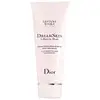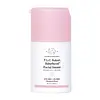What's inside
What's inside
 Key Ingredients
Key Ingredients

 Benefits
Benefits

 Concerns
Concerns

 Ingredients Side-by-side
Ingredients Side-by-side

Water
Skin ConditioningGlycerin
HumectantPolysorbate 20
EmulsifyingGlycolic Acid
BufferingButylene Glycol
HumectantHydroxyethyl Acrylate/Sodium Acryloyldimethyl Taurate Copolymer
Emulsion StabilisingCI 77891
Cosmetic ColorantHydrogenated Polyisobutene
EmollientAlcohol
AntimicrobialCitric Acid
BufferingSodium Hydroxide
BufferingSimmondsia Chinensis Seed Oil
EmollientParfum
MaskingXanthan Gum
EmulsifyingDipotassium Glycyrrhizate
HumectantPhenoxyethanol
PreservativeXylitol
HumectantPolysorbate 60
EmulsifyingSorbitan Isostearate
EmulsifyingTetrasodium EDTA
Ascorbyl Glucoside
AntioxidantSynthetic Fluorphlogopite
Malva Sylvestris Extract
AstringentHibiscus Sabdariffa Flower Extract
Skin ConditioningZea Mays Starch
AbsorbentHydrogenated Lecithin
EmulsifyingSaponins
CleansingLimonene
PerfumingPentaerythrityl Tetra-Di-T-Butyl Hydroxyhydrocinnamate
AntioxidantAframomum Angustifolium Seed Extract
Skin ConditioningPalmaria Palmata Extract
Skin ProtectingSodium Benzoate
MaskingTin Oxide
AbrasivePotassium Sorbate
PreservativeTocopherol
AntioxidantJasminum Officinale Flower Extract
MaskingCI 14700
Cosmetic ColorantWater, Glycerin, Polysorbate 20, Glycolic Acid, Butylene Glycol, Hydroxyethyl Acrylate/Sodium Acryloyldimethyl Taurate Copolymer, CI 77891, Hydrogenated Polyisobutene, Alcohol, Citric Acid, Sodium Hydroxide, Simmondsia Chinensis Seed Oil, Parfum, Xanthan Gum, Dipotassium Glycyrrhizate, Phenoxyethanol, Xylitol, Polysorbate 60, Sorbitan Isostearate, Tetrasodium EDTA, Ascorbyl Glucoside, Synthetic Fluorphlogopite, Malva Sylvestris Extract, Hibiscus Sabdariffa Flower Extract, Zea Mays Starch, Hydrogenated Lecithin, Saponins, Limonene, Pentaerythrityl Tetra-Di-T-Butyl Hydroxyhydrocinnamate, Aframomum Angustifolium Seed Extract, Palmaria Palmata Extract, Sodium Benzoate, Tin Oxide, Potassium Sorbate, Tocopherol, Jasminum Officinale Flower Extract, CI 14700
Water
Skin ConditioningGlycolic Acid
BufferingHydroxyethyl Acrylate/Sodium Acryloyldimethyl Taurate Copolymer
Emulsion StabilisingGlycerin
HumectantSodium Hydroxide
BufferingSalicylic Acid
MaskingAloe Barbadensis Leaf Extract
EmollientCamellia Oleifera Leaf Extract
AstringentLactobacillus/Pumpkin Ferment Extract
Skin ConditioningLactobacillus/Punica Granatum Fruit Ferment Extract
Skin ConditioningOpuntia Ficus-Indica Extract
Skin ConditioningPyrus Malus Fruit Extract
Skin ConditioningSilybum Marianum Seed Extract
Skin ConditioningSaccharomyces Cerevisiae Extract
Skin ConditioningVitis Vinifera Juice Extract
AntioxidantCamellia Sinensis Leaf Powder
ExfoliatingCicer Arietinum Seed Powder
AbrasiveSclerocarya Birrea Seed Oil
HumectantPassiflora Edulis Seed Oil
EmollientLeuconostoc/Radish Root Ferment Filtrate
AntimicrobialSodium Hyaluronate Crosspolymer
HumectantSodium PCA
HumectantAllantoin
Skin ConditioningDipotassium Glycyrrhizate
HumectantDextrin
AbsorbentPolydextrose
HumectantSorbitan Isostearate
EmulsifyingAmylopectin
Niacinamide
SmoothingPhytosphingosine
Skin ConditioningLactic Acid
BufferingPropanediol
SolventCitric Acid
BufferingTitanium Dioxide
Cosmetic ColorantTrisodium Ethylenediamine Disuccinate
Polysorbate 60
EmulsifyingCaprylyl Glycol
EmollientChlorphenesin
AntimicrobialPhenoxyethanol
PreservativeWater, Glycolic Acid, Hydroxyethyl Acrylate/Sodium Acryloyldimethyl Taurate Copolymer, Glycerin, Sodium Hydroxide, Salicylic Acid, Aloe Barbadensis Leaf Extract, Camellia Oleifera Leaf Extract, Lactobacillus/Pumpkin Ferment Extract, Lactobacillus/Punica Granatum Fruit Ferment Extract, Opuntia Ficus-Indica Extract, Pyrus Malus Fruit Extract, Silybum Marianum Seed Extract, Saccharomyces Cerevisiae Extract, Vitis Vinifera Juice Extract, Camellia Sinensis Leaf Powder, Cicer Arietinum Seed Powder, Sclerocarya Birrea Seed Oil, Passiflora Edulis Seed Oil, Leuconostoc/Radish Root Ferment Filtrate, Sodium Hyaluronate Crosspolymer, Sodium PCA, Allantoin, Dipotassium Glycyrrhizate, Dextrin, Polydextrose, Sorbitan Isostearate, Amylopectin, Niacinamide, Phytosphingosine, Lactic Acid, Propanediol, Citric Acid, Titanium Dioxide, Trisodium Ethylenediamine Disuccinate, Polysorbate 60, Caprylyl Glycol, Chlorphenesin, Phenoxyethanol
 Reviews
Reviews

Ingredients Explained
These ingredients are found in both products.
Ingredients higher up in an ingredient list are typically present in a larger amount.
Citric Acid is an alpha hydroxy acid (AHA) naturally found in citrus fruits like oranges, lemons, and limes.
Like other AHAs, citric acid can exfoliate skin by breaking down the bonds that hold dead skin cells together. This helps reveal smoother and brighter skin underneath.
However, this exfoliating effect only happens at high concentrations (20%) which can be hard to find in cosmetic products.
Due to this, citric acid is usually included in small amounts as a pH adjuster. This helps keep products slightly more acidic and compatible with skin's natural pH.
In skincare formulas, citric acid can:
While it can provide some skin benefits, research shows lactic acid and glycolic acid are generally more effective and less irritating exfoliants.
Most citric acid used in skincare today is made by fermenting sugars (usually from molasses). This synthetic version is identical to the natural citrus form but easier to stabilize and use in formulations.
Read more about some other popular AHA's here:
Learn more about Citric AcidDipotassium Glycyrrhizate comes from licorice root.
Extracts of licorice have demonstrated to have antibacterial, anti‐inflammatory, antiviral, antioxidant properties.
One component, glabridin, has extra potent antioxidant and soothing properties. It has also been found to block pigmentation from UVB rays in guinea pigs.
Licorice Root also contains a flavonoid. Flavonoids are a natural substance from in plants. Flavonoids also have antioxidant properties.
Another component, glycyrrhizin, has been found to have anti-inflammatory and antimicrobial benefits. This may make licorice root extract effective at treating acne. However, more research is needed to support this.
Liquiritin is one of the flavone compounds found in licorice. It has been found to help lighten skin by preventing tyrosinase from reacting with tyrosine. When the two react, protein is converted to melanin. Melanin is the substance in your body that gives your features pigmentation.
Licorice root is native to Southern Europe and Asia. It has been used in traditional Chinese medicine to help with respiratory issues.
Learn more about Dipotassium GlycyrrhizateGlycerin is already naturally found in your skin. It helps moisturize and protect your skin.
A study from 2016 found glycerin to be more effective as a humectant than AHAs and hyaluronic acid.
As a humectant, it helps the skin stay hydrated by pulling moisture to your skin. The low molecular weight of glycerin allows it to pull moisture into the deeper layers of your skin.
Hydrated skin improves your skin barrier; Your skin barrier helps protect against irritants and bacteria.
Glycerin has also been found to have antimicrobial and antiviral properties. Due to these properties, glycerin is often used in wound and burn treatments.
In cosmetics, glycerin is usually derived from plants such as soybean or palm. However, it can also be sourced from animals, such as tallow or animal fat.
This ingredient is organic, colorless, odorless, and non-toxic.
Glycerin is the name for this ingredient in American English. British English uses Glycerol/Glycerine.
Learn more about GlycerinGlycolic Acid is arguably the most famous alpha hydroxy acid (AHA) with tons of research backing its benefits.
It is found naturally in sugar cane but the form used in skincare is usually synthetic for purity and stability.
Glycolic acid removes the top layer of dead skin cells to allow newer and fresher ones to emerge.
AHAs work by breaking down the structural “glue” that holds old skin cells in place. When that buildup is gone, your skin can renew itself more efficiently.
Research also shows glycolic acid stimulates collagen production, helping to firm and thicken the skin over time. This is one of its biggest advantages over other AHAs.
Overall, glycolic acid helps with:
Fun fact: Glycolic acid boosts skin hydration by helping it produce molecules that increase hyaluronic acid naturally.
To work best, glycolic acid products should have a pH between 3-4 (that’s where exfoliation is most effective but still gentle on skin).
The pH and concentration of a product are key to its effectiveness:
It is normal to feel a slight stinging sensation when using glycolic acid. This usually fades as your skin adjusts.
Because glycolic acid has the smallest molecular size in the AHA family, it can penetrate deeper, which enhances its effectiveness but also makes it more likely to irritate sensitive skin.
If your skin is very sensitive or prone to rosacea, glycolic acid may be too strong; in that case, try milder options like lactic acid or a PHA instead.
Recent studies suggest glycolic acid might even help protect against UV damage. But don’t skip sunscreen! Freshly exfoliated skin is more sensitive to the sun.
Glycolic acid is a skincare superstar. It smooths, brightens, hydrates, and firms the skin. Unless you’re highly sensitive, it’s well worth adding to your routine.
Read more about some other popular AHA's here:
Learn more about Glycolic AcidThis is a synthetic polymer. It helps improve the texture of products by adding thickness and gel-like feel.
It is also an emulsifer, meaning it prevents ingredients such as oil and water from separating. It also helps evenly disperse other ingredients.
Phenoxyethanol is a preservative that has germicide, antimicrobial, and aromatic properties. Studies show that phenoxyethanol can prevent microbial growth. By itself, it has a scent that is similar to that of a rose.
It's often used in formulations along with Caprylyl Glycol to preserve the shelf life of products.
Polysorbate 60 is used to help stabilize products. It is a surfactant and emulsifier. These properties help keep ingredients together in a product. Surfactants help reduce surface tension between ingredients with different states, such as liquids and solids. Emulsifiers help prevent oils and waters from separating.
Polysorbate 60 is sorbitol-based and created from the ethoxylation of sorbitan. Ethoxylation is a chemical reaction used to add ethylene oxide. Sorbitan is a the dehydrated version of sorbitol, a sugar found in fruits.
In this case, the 60 comes from reacting 60 units of ethylene oxide with sorbitan.
Polysorbates are commonly used in medicine and foods.
Learn more about Polysorbate 60Sodium Hydroxide is also known as lye or caustic soda. It is used to adjust the pH of products; many ingredients require a specific pH to be effective.
In small amounts, sodium hydroxide is considered safe to use. However, large amounts may cause chemical burns due to its high alkaline.
Your skin has a natural pH and acid mantle. This acid mantle helps prevent harmful bacteria from breaking through. The acid mantle also helps keep your skin hydrated.
"Alkaline" refers to a high pH level. A low pH level would be considered acidic.
Learn more about Sodium HydroxideSorbitan Isostearate is an emulsifer and cleaning agent. It is created from isostearic acid and sorbitol.
As an emulsifier, Sorbitan Isostearate prevents oils and water from separating.
Due to its isostearic acid base, it may not be safe for Malassezia or fungal acne.
Learn more about Sorbitan IsostearateWater. It's the most common cosmetic ingredient of all. You'll usually see it at the top of ingredient lists, meaning that it makes up the largest part of the product.
So why is it so popular? Water most often acts as a solvent - this means that it helps dissolve other ingredients into the formulation.
You'll also recognize water as that liquid we all need to stay alive. If you see this, drink a glass of water. Stay hydrated!
Learn more about Water